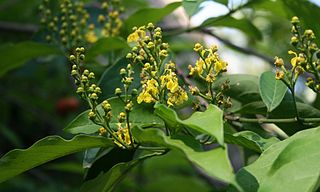
Adrien-Henri de Jussieu was a French botanist.

August Heinrich Rudolf Grisebach was a German botanist and phytogeographer. He was born in Hannover on 17 April 1814 and died in Göttingen on 9 May 1879.

Malpighiaceae is a family of flowering plants in the order Malpighiales. It comprises about 73 genera and 1315 species, all of which are native to the tropics and subtropics. About 80% of the genera and 90% of the species occur in the New World and the rest in the Old World.
Alicia is a genus in the Malpighiaceae, a family of about 75 genera of flowering plants in the order Malpighiales. Alicia comprises 2 species of woody vines widespread in South America.

Franz Josef Niedenzu was a German botanist born in Köppernig. He is remembered for his work with the botanical family Malpighiaceae.
Malpighiodes is a genus in the Malpighiaceae, a family of about 75 genera of flowering plants in the order Malpighiales. Malpighiodes comprises 4 species of woody vines native to northern South America.
Thryallis is a genus in the family Malpighiaceae, of scandent shrubs and woody vines native to Brazil and adjacent Paraguay and Bolivia.

Bunchosia is a genus in the Malpighiaceae, a family of about 75 genera of flowering plants in the order Malpighiales. It contains roughly 75 species of trees and shrubs, which are native to dry woodlands, savannas, and wet forests. Their range extends from Mexico and the Caribbean to southeastern Brazil and adjacent Argentina. Bunchosia is one of three arborescent genera of Malpighiaceae with fleshy, bird-dispersed fruits.

Mascagnia is a genus in the Malpighiaceae, a family of about 75 genera of flowering plants in the order Malpighiales. The genus Mascagnia comprises about 45 species that occur in diverse habitats from northern Mexico and the Caribbean to northern Argentina and south-eastern Brazil.

Stigmaphyllon is a genus in the Malpighiaceae, a family of about 75 genera of flowering plants in the order Malpighiales. Amazonvine is a common name for species in this genus.

José Cuatrecasas (1903–1996) was a botanist. He was born on March 19, 1903 in Camprodon, Catalonia, Spain.
Ectopopterys is a genus in the Malpighiaceae, a family of about 75 genera of flowering plants in the order Malpighiales. Ectopopterys contains only one species of woody vines native to lowland wet forests of Colombia, Ecuador, and Peru.
Mcvaughia is a genus in the Malpighiaceae, a family of about 75 genera of flowering plants in the order Malpighiales. Mcvaughia contains only one species, Mcvaughia bahiana, a shrub occurring in open shrubby vegetation (caatinga) on sandy soils of lowland Bahia, Brazil. It is related to Burdachia and Glandonia.
Blepharandra is a genus in the Malpighiaceae, a family of about 75 genera of flowering plants in the order Malpighiales. Blepharandra comprises 6 species of trees and shrubs native to sandy savannas and scrub forests of Guyana, southern Venezuela, and Amazonian Brazil.
Psychopterys is a genus in the Malpighiaceae, a family of about 75 genera of flowering plants in the order Malpighiales. Psychopterys comprises 8 species of woody vines, occasionally described as shrubs or small trees, which occur in matorral, tropical deciduous forest, and wet forest in southern Mexico, Guatemala, and Belize. This genus is very distinctive because of its nearly radial white corollas and eglandular sepals, which are highly unusual characteristics in the Malpighiaceae of the New World.
Burdachia is a genus in the Malpighiaceae, a family of about 75 genera of flowering plants in the order Malpighiales. Burdachia comprises 3 species of trees and shrubs occurring in lowland forests near rivers or in low, periodically flooded places in Guyana and Amazonian Venezuela, Colombia, Brazil, and Peru.
Christianella is a genus in the Malpighiaceae, a family of about 75 genera of flowering plants in the order Malpighiales. Christianella comprises 5 species of woody vines and shrubby habit occurring in forests, roadside thickets, and shrubby savannas in southeastern Mexico, Central America, and South America.
Calcicola is a genus in the Malpighiaceae, a family of about 75 genera of flowering plants in the order Malpighiales. Calcicola comprises 2 species of shrubs or treelets native to Mexico.

Aspidopterys is a genus of Malpighiaceae, a family of about 75 genera of flowering plants in the order Malpighiales. Aspidopterys comprises approximately 15 species of vine native to Asia.
Dicella is a genus in the Malpighiaceae, a family of about 75 genera of flowering plants in the order Malpighiales. Dicella includes seven species, assigned to two sections. Section Dicella comprises D. bracteosa and D. nucifera, found in southeastern Brazil and adjacent Paraguay and Argentina. Section Macropterys includes D. aciculifera, known only from Costa Rica, and D. conwayi, D. julianii, D. macroptera, and D. oliveirae, all of South America from Colombia south to about 19°S









